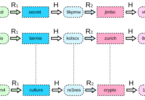The most recent generative AI programs can handle various everyday tasks, such as data rearrangement and categorization. They possess the ability to write compelling fiction, compose captivating music, and craft digital art that has received recognition. This has inspired people to venture into their creative endeavors, attracting attention. As a result, more stakeholders are struggling with the impact of generative AI on business and society, but with no context to help them make sense of it.
One-third of firms use generative AI routinely in at least one business function, less than a year after several of these tools first emerged.
What Exactly Is Generative AI?
AI is a branch of computer science that teaches computer systems to execute activities traditionally performed by humans using a method or set of rules known as algorithms. Generative AI platforms refer to the methods by which AI systems produce outputs like text, images, videos, code, and 3D visuals based on the data they’ve learned.
AI products can generate textual, graphic, and audio material and software applications with minimal human intervention. Industries, such as advertising, entertainment, and creative and analytical jobs may be among the first to experience the consequences. People in these sectors may be concerned that firms would employ generative AI to do tasks they once did, while economists see significant potential to increase overall labor productivity.
Why Is Generative AI So Popular?
ChatGPT has been available since November 2022. Four months later, OpenAI released GPT-4, a new large language model with greatly enhanced capabilities. Similarly, by May 2023, Anthropic’s generative AI, Claude, could analyze 100,000 tokens of text every minute, equivalent to around 75,000 words per minute (the length of an average novel) up from about 9,000 tokens when it debuted in March 2023.
As this technology advances, the popularity of generative AI is projected to rise even further, opening up new opportunities and determining the future of numerous sectors.
Reasons for AI success
For several strong reasons, generative AI has grown in popularity:
- Generative AI can produce fresh and unique material, such as artwork, music, and literature, that was previously only achievable through human ingenuity.
- From personalized product recommendations to tailored content, generative AI improves consumer engagement and happiness, resulting in brand loyalty and revenue development.
- Businesses can save time and money by using AI for data analysis, content development, and customer support.
- AI technologies improve interactions with digital platforms, from chatbots offering immediate help to virtual assistants anticipating user needs.
- This results in data-driven insights and predictive analytics, allowing organizations to make informed decisions and remain competitive.
- Generative AI has been used in a variety of creative industries like art, design, and music.
- AI tools and platforms are becoming more user-friendly, making it possible for non-experts to leverage AI’s potential for various applications.
- Companies that adopt generative AI gain a competitive advantage by providing new solutions, personalized experiences, and efficient processes.
Top Generative AI Tools in 2023
- GPT-4 is OpenAI’s most recent LLM, and it is more innovative, accurate, and secure than its predecessors. It also has multimodal capabilities, which means it can handle photos, PDFs, CSVs, etc. GPT-4 can now execute its code to offer correct responses, thanks to the introduction of the Code Interpreter.
- OpenAI’s GPT-4 model powers Bing AI to look up the right answers online. It can also produce graphics based on user suggestions.
- GitHub Copilot is an AI code completion tool that analyzes code and delivers fast feedback and relevant code suggestions.
- DALL-E 2 is an OpenAI text-to-image generating application that generates original graphics depending on the user’s prompt. It is programmed to deny incorrect user requests.
- Firefly is a program for picture creation and modification known for its prompt-to-image output accuracy. It has many picture editing capabilities, including content type, color, tone, lighting, and composition tools.
- Bard is a Google chatbot viewed as Google’s alternative to OpenAI’s ChatGPT.
- Anthropic created a chatbot named Claude. It works similarly to ChatGPT in handling enormous quantities of text and automating processes.
- Synthesia is a video creation tool that uses AI avatars and voiceovers to convert texts into high-quality films.
- Microsoft Designer generates posters, graphics, and artwork based on the user’s input.
- Midjourney is another picture production program that generates graphics based on the user’s input. It excels at producing locations that resemble concept art from a video game, particularly in the fantasy and sci-fi genres.
What Can We Anticipate from Generative AI in the Coming Years?
We may anticipate generative AI to make tremendous advances and have a disruptive influence across several disciplines shortly.
- Increased personalization. From product suggestions to content and marketing tactics, AI will better grasp individual tastes and create more tailored experiences.
- AI co-creation. Generative AI will collaborate with humans on creative tasks such as painting, music, and content development, resulting in original and inventive products.
- Ethical AI. Efforts will be made to ensure that generative AI is used responsibly and ethically, addressing concerns about disinformation and potential biases.
- AI-powered research. Scientific research, drug discovery, and other industries will benefit from generative AI, resulting in breakthroughs and fresh insights.
- AI in everyday life. AI-powered virtual assistants and chatbots will become increasingly common, effortlessly integrating into routine tasks and interactions.
The potential for generative AI to change businesses and drive societal progress is enormous. AI’s capabilities solve complicated issues and pave the way for a more connected and automated future, spanning sectors from healthcare to education.







